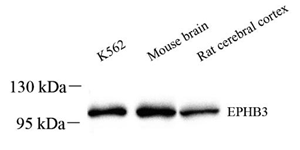Anti-Eph receptor B3 Rabbit pAb (100 μl)
| Reactivity: | M,R & M,R |
| Applications: | WB & IHC/IF |
| Host Species: | Rabbit |
| Clonality: | Polyclonal |
| Full Name: | Eph receptor B3 rabbit polyclonal |
Gene Name: | Ephrin type-B receptor 3 |
Synonyms: | Developmental kinase 5, Tyrosine-protein kinase receptor SEK-4, mDK-5, Ephb3, Etk2, Mdk5, Sek4 |
Immunogen: | Recombinant protein corresponding to Mouse Eph receptor B3 |
Isotype: | IgG |
Purity: | Affinity purification |
Predicted MW. | 110 kDa |
Observed MW. | 110 kDa |
Uniprot ID: |
Product Usage Information
Applications | Species | Dilution | Positive tissue |
WB | Human, Mouse, Rat | 1: 300-1: 600 | brain, cerebral cortex |
Background
The Eph subfamily represents the largest group of receptor protein tyrosine kinases identified to date (1–3). While the biological activities of these receptors have yet to be determined, there is increasing evidence that they are involved in central nervous system function and in development (1–3). The Eph subfamily receptors of human origin (and their murine/avian homologs) include EphA1 (Eph), EphA2 (Eck), EphA3 (Hek4), EphA4 (Hek8), EphA5 (Hek7), EphA6 (Hek12), EphA7 (Hek11/MDK1), EphA8 (Hek3), EphB1 (Hek6), EphB2 (Hek5), EphB3 (Cek10, Hek2), EphB4 (Htk), EphB5 (Hek9) and EphB6 (Mep). Ligands for Eph receptors include ephrin-A4 (LERK-4) which binds EphA3 and EphB1. In addition, ephrin-A2 (ELF-1) has been described as the ligand for EphA4, ephrin-A3 (Ehk1-L) as the ligand for EphA5 and ephrin-B2 (Htk-L) as the ligand for EphB4 (Htk) (4–7).
Images
 | Western blot analysis of EPHB3 (GB113310) at dilution of 1: 600 |
Storage
| Storage | Store at -20°C for one year. Avoid repeated freeze/thaw cycles. |
| Storage Buffer | PBS with 0.02%sodium azide,100 μg/ml BSA and 50% glycerol. |



